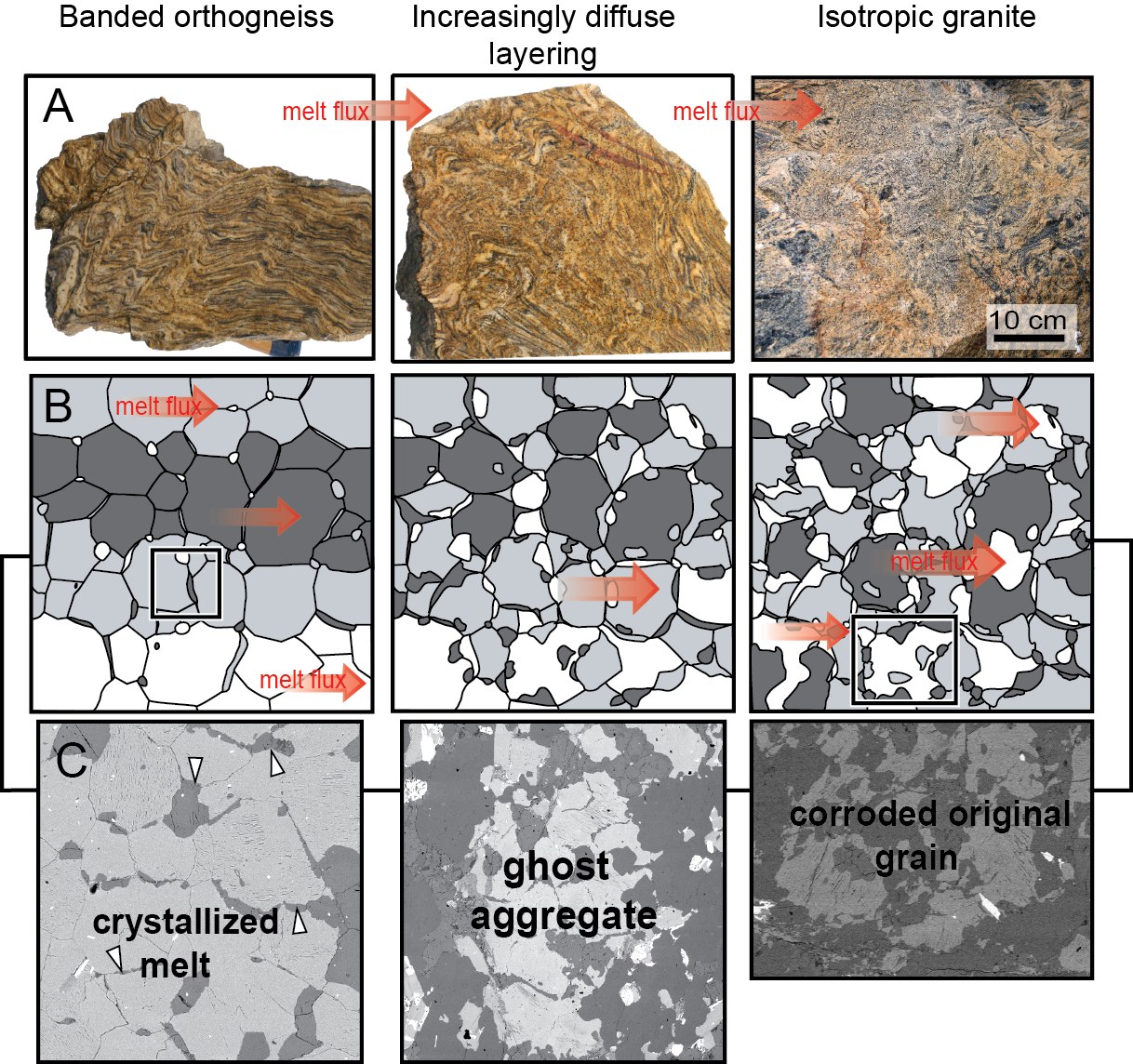Melting and melt migration in the continental crust
Melt transfers mass, heat and volatiles from the Earth’s depth towards the surface. Melting and subsequent melt migration therefore crucially affect the chemical and thermal structure of the lithosphere. There are two distinct melting processes in the continental crust: dehydration melting involving breakdown of hydrated silicates and water-fluxed melting that requires the presence of hydrous fluid. Dehydration melting of continental rocks is relatively well understood and documented. Here at CLR we focus on water-fluxed melting and its role for subsequent melt migration through the crust.
Example of leucosomes formed by dehydration melting (left) and water-fluxed melting (right) of the same orthogneiss in Zanskar, NW Himalaya [link].
The current understanding of crustal melt migration is biased towards mechanisms that preserve macroscopic segregation of melt in outcrops, such as dyking or leucosome-bearing migmatites, while other mechanisms that leave less obvious traces in the geological record are often neglected. This is the case of the grain-scale pervasive melt flow that was first described here at CLR and is the scope of many further studies. At CLR, we study this process using a multidisciplinary approach that combines field-based studies including microstructures, mineral chemistry, pressure-temperature (PT) modeling, geochemistry, geochronology and numerical thermal-mechanical simulations.
Micro-scale pervasive melt migration can explain a number of micro- to mesoscopic features in large migmatitic terranes. At CLR we have studied examples from the Bohemian Massif [link] [link] [link] [link], Vosges Mountains [link], Madagascar and NW Himalaya [link]. In all the studied areas, microscale pervasive through-flow of melt leads to significant modification of rock chemistry, mineral composition and microstructure. Without disaggregating the solid rock framework at any time, melt flow progressively destroys pre-existing fabrics and modifies the protolith chemical and isotopic signature. Eventually, the protolith becomes isotropic diatexite- to granite-like, with ghosts of the original fabric. This process has profound implications for rheology and deformation of the affected terranes.
Pervasive melt flow and changes it is causing in rocks and rock microstructures. Bottom row shows typical features to recognize interaction between host rock and melt.
In addition to detailed characterization of the melt-fluxed rocks by means of geological methods, we have developed thermo-mechanical numerical models that can elucidate the dynamics of porous melt flow. Results of our modelling show several features that are characteristic for the continental crust in hot orogenic systems. The models suggest that despite its slowness, the grain-scale porous flow can be a viable and persistent mechanism of melt transport in the continental crust.
A numerical model showing formation of partially-molten regions in the middle and lower crust. Right panel shows compositional stratification into the "granitic" middle crust and "restitic" lower crust that developed due to melt migration [link].
Related projects
Pervasive melt migration in continental crust: a micro-scale process with large-scale implications (2023–2025)
Generation, extent, and longevity of magma mush columns (2023–2025)
Granulite-migmatite domes - insight into the Devonian and Carboniferous development of the Variscan belt (2019–2021)
Melting the metagranitoids: important but poorly understood aspect of crust evolution (2016–2018)
Tracking magmas from source to pluton: new insight into granites diversity (2014–2016)



